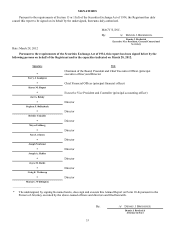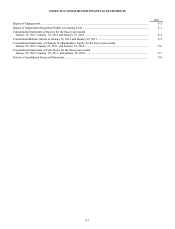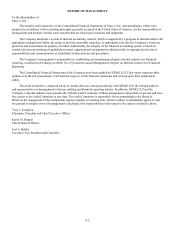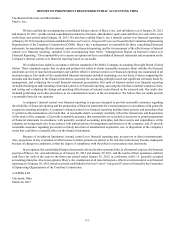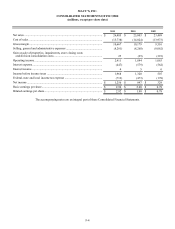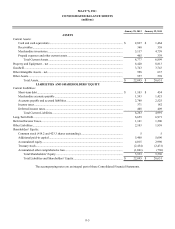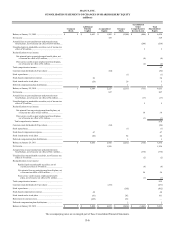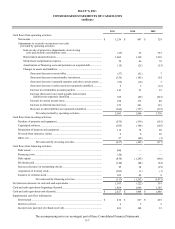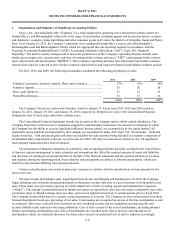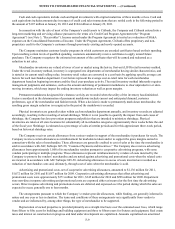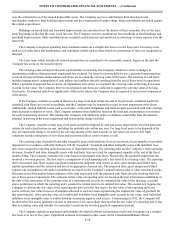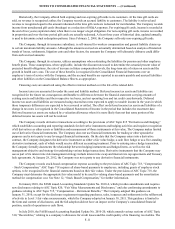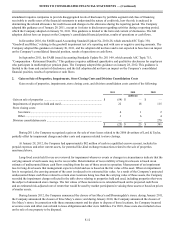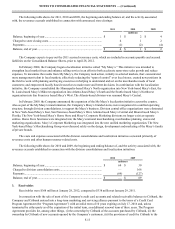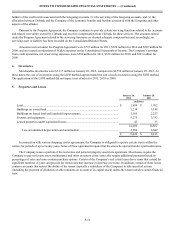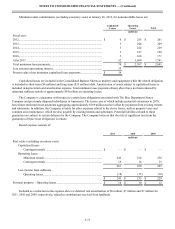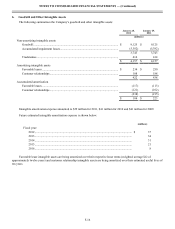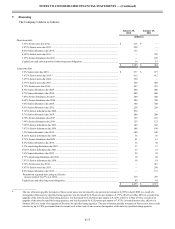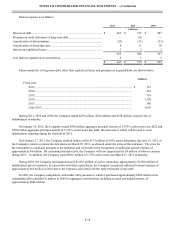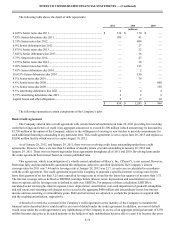Macy's 2011 Annual Report Download - page 49
Download and view the complete annual report
Please find page 49 of the 2011 Macy's annual report below. You can navigate through the pages in the report by either clicking on the pages listed below, or by using the keyword search tool below to find specific information within the annual report.
NOTES TO CONSOLIDATED FINANCIAL STATEMENTS — (Continued)
F-9
Cash and cash equivalents include cash and liquid investments with original maturities of three months or less. Cash and
cash equivalents includes amounts due in respect of credit card sales transactions that are settled early in the following period in
the amount of $107 million at January 28, 2012 and $104 million at January 29, 2011.
In connection with the sale of most of the Company’s credit assets to Citibank, the Company and Citibank entered into a
long-term marketing and servicing alliance pursuant to the terms of a Credit Card Program Agreement (the “Program
Agreement”) (see Note 3, “Receivables”). Income earned under the Program Agreement is treated as a reduction of SG&A
expenses on the Consolidated Statements of Income. Under the Program Agreement, Citibank offers proprietary and non-
proprietary credit to the Company’s customers through previously existing and newly opened accounts.
The Company maintains customer loyalty programs in which customers are awarded certificates based on their spending.
Upon reaching certain levels of qualified spending, customers automatically receive certificates to apply toward future
purchases. The Company recognizes the estimated net amount of the certificates that will be earned and redeemed as a
reduction to net sales.
Merchandise inventories are valued at lower of cost or market using the last-in, first-out (LIFO) retail inventory method.
Under the retail inventory method, inventory is segregated into departments of merchandise having similar characteristics, and
is stated at its current retail selling value. Inventory retail values are converted to a cost basis by applying specific average cost
factors for each merchandise department. Cost factors represent the average cost-to-retail ratio for each merchandise
department based on beginning inventory and the fiscal year purchase activity. The retail inventory method inherently requires
management judgments and estimates, such as the amount and timing of permanent markdowns to clear unproductive or slow-
moving inventory, which may impact the ending inventory valuation as well as gross margins.
Permanent markdowns designated for clearance activity are recorded when the utility of the inventory has diminished.
Factors considered in the determination of permanent markdowns include current and anticipated demand, customer
preferences, age of the merchandise and fashion trends. When a decision is made to permanently mark down merchandise, the
resulting gross margin reduction is recognized in the period the markdown is recorded.
Physical inventories are generally taken within each merchandise department annually, and inventory records are adjusted
accordingly, resulting in the recording of actual shrinkage. While it is not possible to quantify the impact from each cause of
shrinkage, the Company has loss prevention programs and policies that are intended to minimize shrinkage. Physical
inventories are taken at all store locations for substantially all merchandise categories approximately three weeks before the end
of the fiscal year. Shrinkage is estimated as a percentage of sales at interim periods and for this approximate three-week period,
based on historical shrinkage rates.
The Company receives certain allowances from various vendors in support of the merchandise it purchases for resale. The
Company receives certain allowances as reimbursement for markdowns taken and/or to support the gross margins earned in
connection with the sales of merchandise. These allowances are generally credited to cost of sales at the time the merchandise is
sold in accordance with ASC Subtopic 605-50, “Customer Payments and Incentives.” The Company also receives advertising
allowances from approximately 1,000 of its merchandise vendors pursuant to cooperative advertising programs, with some
vendors participating in multiple programs. These allowances represent reimbursements by vendors of costs incurred by the
Company to promote the vendors’ merchandise and are netted against advertising and promotional costs when the related costs
are incurred in accordance with ASC Subtopic 605-50. Advertising allowances in excess of costs incurred are recorded as a
reduction of merchandise costs and, ultimately, through cost of sales when the merchandise is sold.
Advertising and promotional costs, net of cooperative advertising allowances, amounted to $1,136 million for 2011,
$1,072 million for 2010 and $1,087 million for 2009. Cooperative advertising allowances that offset advertising and
promotional costs were approximately $371 million for 2011, $345 million for 2010 and $298 million for 2009. Department
store non-direct response advertising and promotional costs are expensed either as incurred or the first time the advertising
occurs. Direct response advertising and promotional costs are deferred and expensed over the period during which the sales are
expected to occur, generally one to four months.
The arrangements pursuant to which the Company’s vendors provide allowances, while binding, are generally informal in
nature and one year or less in duration. The terms and conditions of these arrangements vary significantly from vendor to
vendor and are influenced by, among other things, the type of merchandise to be supported.
Depreciation of owned properties is provided primarily on a straight-line basis over the estimated asset lives, which range
from fifteen to fifty years for buildings and building equipment and three to fifteen years for fixtures and equipment. Real estate
taxes and interest on construction in progress and land under development are capitalized. Amounts capitalized are amortized


